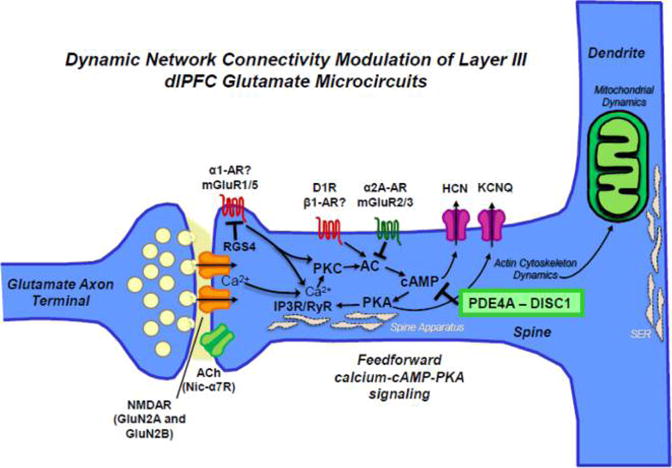Figure 6.

DNC in primate dlPFC layer III. Schematic summarizing the molecular regulators of DNC in dlPFC layer III NMDAR synapses on long, thin spines that permit biochemical/electrical compartmentalization of signaling. These synapses are mediated by NMDAR with either GluN2A or GluN2B subunits. In primate dlPFC, the permissive depolarization for NMDAR-containing synapses is provided by powerful influences of acetylcholine through nicotinic α7 receptors (nic-α7Rs). Negative feedback in these recurrent circuits is provided by feedforward calcium–cAMP– PKA signaling, which open HCN and KCNQ channels near the synapse to weaken connectivity. Internal calcium release from the spine apparatus (i.e., the SER in the spine) may be initiated by calcium influx through NMDAR by activation of type I metabotropic glutamate receptors (e.g., mGluR1 or mGluR5) activation of Gq signaling or by catecholamine activation of Gq or Gs-cAMP signaling, e.g. as occurs during stress exposure. RGS4 is positioned to regulate Gq signaling near the synapse. A variety of mechanisms regulate cAMP signaling. For example, moderate levels of norepinephrine release during nonstressed conditions engage high affinity α2A-ARs that inhibit cAMP opening of HCN and KCNQ channels to strengthen connections and enhance cognition. Recent data show that postsynaptic mGluR3 also performs this key strengthening action. cAMP signaling is also powerfully regulated by PDE4A, which is anchored to the spine apparatus by DISC1. As the spine apparatus interconnects with the SER in the dendrite, these mechanisms also allow communication between the synapse and the dendrite, e.g. with mitochondria residing in the nearby dendrite. Thus, regulation of feedforward cAMP–calcium signaling mechanisms is crucial to maintain normal mitochondrial function and the actin dynamics needed for the structural integrity of dendritic spines. Abbreviations: NMDAR, N-methyl-D-aspartate receptor; mGluR, metabotropic glutamate receptor; ACh, acetylcholine receptor; α2-AR/α1-AR, α2-A/α1 adrenoreceptors; D1R, dopamine receptor D1; cAMP, cyclic adenosine monophosphate; PKA, protein kinase A; PKC, protein kinase C; AC, adenylyl cyclase; RyR, ryanodine receptor; IP3R, inositol-1,4,5-triphosphate receptors; RGS4, regulator of G protein signaling 4; PDE4A, phosphodiesterase 4A; DISC1, Disrupted in Schizophrenia 1.
